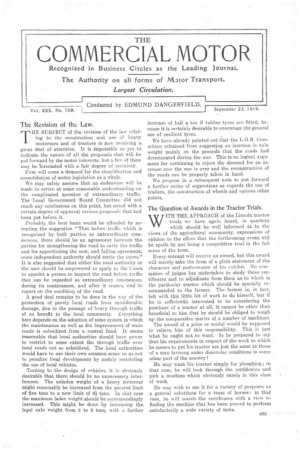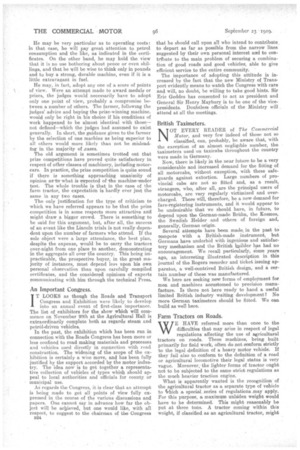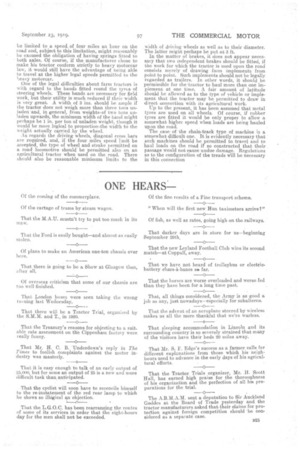Vol. XXX. No. 759. Conducted by EDMUND DANGERFIELD. September 23, 1919.
Page 1

Page 2

Page 3

If you've noticed an error in this article please click here to report it so we can fix it.
The Revision of the Law.
THE SUBJECT of the revision of the law relating to the construction and use of heavy. motorcars and of tractors is now receiving a great deal of attention. It is impossible as yet to indicate the nature of all the proposala that will be put forward by the motor interests, but a few of them may be Three:fisted with a fair degree of certainty.
First will come a, deruand for the simplification and consolidation of motor legislation as a whole.
We may safely assume that an endeavour will be made to arrive at some reasonable understanding on the complicated question of extraordinary traffic. The Local Government Board Committee did not reach any conclusions on this point, but noted with a certain degree of approval various proposals that had been put before it.
Probably the best basis would be afforded by accepting the suggestion "That before traffic which is recognized by both parties as extraordinary commences, there should be an agreement between the parties for strengthening the road to carry the traffic and for apportioning the cost, and failing agreement, HOMO independent authority should settle the terms." It is also suggested that either the road authority or the user should be empowered to apply to the Court to appoint a person to inspect the road before traffics that can be regarded as extraordinary commences, during its continuance, and after it ceases, and to report on the condition of the road.
A good deal remainsto be done in the way of the protection of purely local roads from considerable damage, due to the passage of heavy through traffic of no benefit to the local community. Everything here depends on the adoption of some system in which the maintenance as well as the improvement of main roads is subsidized from a central lurid. It seems reasonable that local authorities should. have power to restrict to sorae extent the through traffic over local roads not so subsidized. The local authorities would have to use their own common sense so as not to penalize Meal development by unduly restricting the use of local vehicles.
Turning to the design of vehicles, it is obviously desirable that there should be no uneecessary interference. The unladen weight of a heavy motorcar might reasonably be increased from the present limit of five tons to a new limit of al tons. In that case the maximum laden weight should be correspondingly increased. This might be done by increasing the legal axle weight from 8 to 9 tons, with a further increase of half a ton if rubber tyres are fitted, because it is certainly desirable to encourage the general use of resilient tyres.. a . We have already pointed out that the L.G.B. Committee refrained from suggesting an increase in axle weight mainly on the grounds that the roads had deteriorated during the war. This is no logical argument for continuing to reject the demand for an increase now the war is over and the reconstruction of the roads can be properly taken in hand.
We propose in a 'subsequent note to put forward a further series of suggestions as regards the use of trailers, the construction of wheels and various other points.
The Question of Awards in the Tractor Trials.
WITU THE APPROACH of the Lincoln tractor trials we have again heard, in quarters which 'should be well informed as to the views of the agricultural community, expressions of opinion to the effect that the forthcoming event will be spoilt by not being a competitive trial in the full sense of the term.
Every entrant will receive an award, but this award will merely take the form of a plain statement of the character and performance of his exhibit. No committee of judges has undertaken to study these certificates and to adjudicate from theta as to which is the particular tractor which should be specially recommended to the farmer. The farmer is, in fact, left with this little bit of work to do himself, but if he is sufficiently interested to be considering the purchase of a tractor at all, it cannot be other than beneficial to him that he should be obliged to weigh up the comparative merits of a number of machines. The award of a prize or medal would be supposed to relieve him of this responsibility. This is just what he ought not to want. • Is he prepared to say that his requirements in respect of the work to which he means to put his tractor are just the same as those of a man farming under dissimilar conditions in some other part of the country?
He may want his tractor simply for ploughing ; in that case, he will look through the certificates and pick a machine which obviously excel& in this class of work.
Ile may wish to use it for a variety of purposes as a general substitute for a team of horses: in that case, he will search the certificates with a view to finding the machine that has been proved to perform satisfactorily a wide variety of tests. He may be very particular as to operating costs: in that case, he will pay great attention to petrol consumption and the like, as indicated in the certi ficates. On the other hand, he may hold the view that it is no use bothering about pence or even shillings, and that he will be wise to think only in pounds and to buy a strong, durable machine, even if it is a little extravagant in fuel.
He may, in fact, adopt any one of a score of points of view. Were an attempt made to award medals or prizes, the judges would necessarily have to adopt only one point of view, probably a compromise between a number of others. The farmer, following the judges' advice and buying the prize-winning machine, would only be right in his choice if his conditions of work happened to be almost identical with those— not defined—which the judges had assumed to exist generally. In short, the guidance given to the farmer by the selection of one machine as being superior to all others would more likely than not be misleading in the majority of .cases. The old argument is sometimes trotted out that prize competitions have proved quite satisfactory in respect of other classes of machinery, including motorcars. In practice, the prize competition is quite sound if there is something approaching unanimity of opinion as-to what is expected of -the machine-under test. The whole trouble is that in the case of the farm tractor, the expectaticin is hardly ever just the same in any two cases. . The only justification for the type of criticism to -which we have referred appears to be that the prize competition is in some respects more attractive and might draw .a bigger crowd. There is something to be said for this argument, but, after all, the success of an event like the Lincoln trials is not really dependent upon the number of farmers who attend. If the sole object were a. large attendance, the best plan, despite the expense, would be to carry the tractors over-night from one place to another, demonstrating in the aggregate all over the country. This being impracticable, the prospective buyer, in the great majority of instances, must depend less upon his own personal observation than upon carefully compiled certificates, and the considered opinions of experts communicating with him through the technical Press.
An Important Congress.
IT LOOKS as though the Roads and Transport Congress and Exhibition were likely to develop into an annual event of first-class importance. The list of exhibitors for the show which will commence on November 20th at the Agricultural Hall is extraordinarily complete both as regards steam and petrol-driven vehicles. In the past, the exhibition which has been run in connection with the Roads Congress has been more or less confined to road making materials and processes and vehicles used directly in connection with toed construction. The widening of the scope of the exhibition is certainly a wise move, and has been fully justified by the support accorded by the motor industry. The idea now is to get together a representative collection of vehicles of types which should appeal to local authorities and officials for county, or municipal use. As regards the Congress, it is clear that an attempt is being made to get all points of view fully expressed in the course of the various discussions and papers. One cannot say in advance how far the object will be achieved, but one would like, with all respect, to suggest to the chairman of the Congress that he should call upon all who intend to contribute to depart as far as possible from the narrow lines suggested by their own personal interest and to contribute to the main problem of securing a combination of good roads and good vehicles, able to give efficient service to the entire community. • The importance of adopting this attitude is increased by the fact that the new Ministry of Transport evidently means to watch the Congress with care and will, no doubt, be willing to take good hints. Sir Erie Geddes has consented to act as president and General Sir Henry Maybury is to be one of the vicepresidents. Doubtless officials of the Ministry will attend at all the meetings.
British Taximeters.
NOT EVERY READER of The Commercial Motor, and very few indeed of those not so classified, can, probably, be aware that, with the exception of an almost negligible number, the taximeters used on taxicabs throughout the country were made in Germany. Now, there is likely in the near future to be a very considerable and inereaeed demand for the fitting of all motorcabs, without exception, with these safeguards against extortion. Large nuraleers of provincial cahe are not so fitted and, as a result, strangers, who, after all, are the principal users of motorcabs, are very regularly victimized and overcharged. There will, therefore, be anew demand for fare-registering instruments, and it would appear to be undesirable that we should have, in future, to depend upon the German-made Briihn, the Kosmos, the Swedish Helder and others • of foreign and, generally, German origin. Several attempte have been made, in the past to compete with a British.-made instrument, but Germans have underbid with ingenious and satisfactory mechanism and the British lanilder hias had no encouragement. We recall particularly, some years ago, an interesting illustrated description in this journal of the Rogers. recorder and ticket issuing apparatus, a well-contrived British design, and a certain number of these wee manufactured.
We here are seeking new forms of emploYment for men and machines accustomed to precision manufacture. Is there not here ready to hand a. useful limited British industry waiting development? No more German taximetera should be fitted. We can build as well here.
Farm Tractors on Roads.
WE HAVE referred more than once to the difficulties that may arise in respect of legal regulations affecting the use of agricultural tractors on roads. These machines, being built primarily for field work, often do not conform strictly to the legal definition of a heavy motor vehicle. If they fail also to .c,onform to the definition of a road or agricultural locomotive their legal status is very vague. AtIoreoverethe lighter forms of tractor ought not to be subjected to the same strict regulations as the much heavier traction engine. What is apparently wanted is the reeognition of the agricultural tractor as a separate type of vehicle to (vhich a. special, series of regulations may apply. For this purpose, a maximum unladen weight would have to be determined. This might reasonably he put at three tons. A tractor coming within this weight, if classified as an agricultural tractor, might be limited to a speecL of four miles an hour on the road and, subject to this limitation; might reasonably be excused the obligation of having springs fitted to both axles. Of course, if the manufacturer chose to make his tractor conform strictly to heavy motorcar law, it would still have the advantage of being able to travel at the higher legal speeds permitted to the heavy motorcar.
One of the legal difficulties about farm tractors is with regard to the bands fitted round the tyres of steering wheels. These bands are necessary for field work, but their utility is much reduced if their width is very great. A width of 3 ins, should be ample if the tractor does not weigh more than throe tons unladen and, in general, from weights-of two tons unladen upwards; the minimum width of the band might perhaps be j in. per ton of unladen weight, though it would be more logical to proportion-41/e width to the weight actually carried by the wheel. • As regards the driving wheels, diagonal cross bars are required, and, if the .four miles speed limit be accepted, the type of wheel and strake permitted on a road locomotive should be permitted also on an agricultural tractor when used on the road. There should also be reasonable minimum limits to the width of driving wheels as well as to their diameter. The•latte.r might perhaps be put at 3 ft. In the matter of brakes, it does not appear necessary that two independent brakes should be fitted, if the work for which the tractor is used upon the road consists merely of drawing farm implements from point to point. Such implements should not be legally regarded as trailers. In other words, it should be permissible for the'tractor to haul more than one implement at one time. A fair amount of latitude should be allowed as to the type of vehicle Or implement that the tractor may be permitted to draw in direct connection with its agricultural work. Up to the present, it has been assumed that metal tyres are used on all wheels. Of course, if rubber tyres are fitted it would be only proper to allow a somewhat higher speed when loads are being hauled upon the road.
The case, of the chain-track type of machine is a somewhat difficult one.. It is evidently necessary that such machines should, he permitted to travel and to haul loads on the road if se constructed that their passage would not cause undue damage. Regulations as to the configuration of the treads will be necessary in this connection •
























